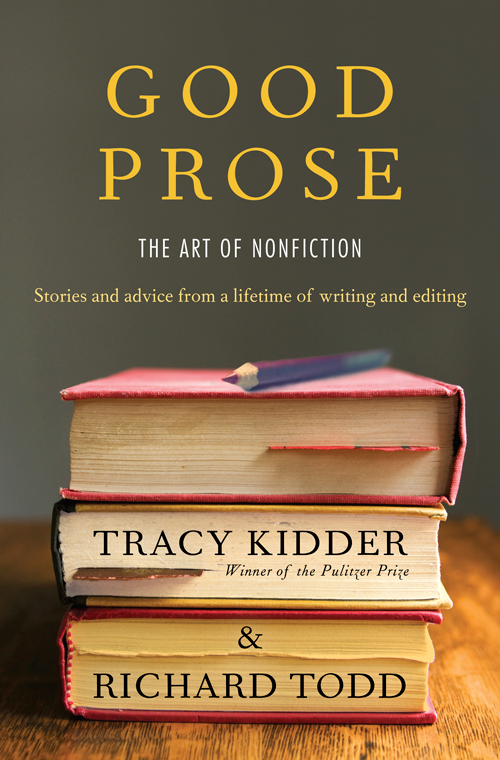In the book Good Prose: The Art of Nonfiction, memorably instructive lines for writers and editors appear on almost every page. The authors, the Pulitzer-winning nonfiction writer Tracy Kidder and his longtime editor, Richard Todd, broke the work into eight chapters — “Narratives,” “Being Edited and Editing,” “Beyond Accuracy” — and there is something useful, and even inspiring, in every one. Kidder is the author of books that include Mountains beyond Mountains, Among Schoolchildren, and The Soul of a New Machine; Todd is the author of the exquisite book of essays The Thing Itself: On the Search for Authenticity. Their relationship began more than three decades ago, at The Atlantic, and Good Prose is as much a memoir of their collaboration as it is a guide to storytelling. Here are 20 insightful lines and passages:
“Every story has to be discovered twice, first in the world, and then in the author’s study. One discovers a story the second time by constructing it.”
“Writers want to be engaging, and it is easy to try to purchase charm at the expense of honesty, but the ultimate charm lies in getting the face more right than pretty.”
“The heart of the story is usually a place to arrive at, not a place to begin.”
“The wise writer, while striving to avoid self-consciousness, remains aware of the reader’s probing eye.”
 “ ‘Play it like you don’t know how.’ Cryptic advice, but a writer can make some sense of it: Don’t concentrate on technique, which can be the same as concentrating on yourself. Give yourself to your story, or to your train of ideas, or to your memories. Don’t be afraid to explore, even to hesitate. Be willing to surprise yourself.”
“ ‘Play it like you don’t know how.’ Cryptic advice, but a writer can make some sense of it: Don’t concentrate on technique, which can be the same as concentrating on yourself. Give yourself to your story, or to your train of ideas, or to your memories. Don’t be afraid to explore, even to hesitate. Be willing to surprise yourself.”
“It isn’t always a bad sign when a story doesn’t talk well.” (Meaning don’t worry about it if the idea doesn’t pass the cocktail-party test.)
There are many archetypal stories: narratives of quest and trial, sin and redemption, identity and self-sacrifice; narratives of the chase, the mystery, the love triangle, the struggle between good and evil; narratives in which trouble is averted, escape is achieved, tragedy happens. Many, maybe most, nonfiction writers go looking for narratives with those silhouettes, and they feel lucky when they find the real thing, because stories out in the world don’t usually turn out as expected. Even a story that has already happened, a story that a writer sets out to reconstruct, isn’t always as dramatic as it first appears. The villain isn’t quite as villainous as he looked in the photograph; the warring parties settle the lawsuit in midtrial; the murder wasn’t a murder after all. Nonfiction writers, especially ones new to the factual narrative, are vulnerable to those sorts of disappointments. ‘I don’t have a book,’ the young writer says when the events don’t deliver the kind of obvious drama in which everyone recognizes a story. But what’s usually missing isn’t a story. What’s missing is a broader way of thinking about what makes for a good story.”
“The most important conflict often happens within a character, or within the narrator.”
“For a story to have a chance to live, it is essential only that there be something important at stake.”
“Point of view is the place from which a writer listens in and watches. Choosing one place over another determines what can and can’t be seen, what minds can and can’t be entered. The choice also deeply affects the tone, the author’s apparent attitude toward the events and people of a story.”
“Point of view is a place to stand, but more than that, a way to think and feel.”
“Against a large background, ‘I’ can provide human scale. … As a rule, the smaller the canvas, the more intrusive the first person is likely to be.”
“The goal is to get the characters off the page and into the reader’s imagination.”
“What the imaginative reader wants is telling details. Characters can emerge in long descriptive passages, as in Tolstoy, but brevity can also work. Graham Greene rarely gives us more than a detail or two—a face ‘charred with a three days’ beard’ or a pair of ‘bald pink knees’—and Jane Austen often gives us less than that, and yet the people those writers create have come alive for generations of readers.”
“What we want are essences, woven into a story in moments large and small.”
“Minor characters encountered in the flow of a story can function as lenses on the main characters.”
“Above all, a setting tells what is at issue—what a character is trying to do, what a character fears or is trying to hide, hopes to gain or stands to lose, what a character is up against.”
“The honest nonfiction storyteller is a restrained illusionist.”
“It is always a good idea to construct a detailed timeline and, for some, to write rough drafts chronologically. If you know the actual sequence of your story, all the details dated in relation to one another, you avoid muddle and misunderstanding, and can write with a feeling of authority, which tends to insinuate itself into prose.”
F. Scott Fitzgerald “knew that there are at least two kinds of rewriting. The first is trying to fix what you’ve already written, but doing this can keep you from facing up to the second kind, from figuring out the essential thing you’re trying to do and looking for better ways to tell your story.”
Bonus: Watch Kidder and Todd talk about their relationship:


